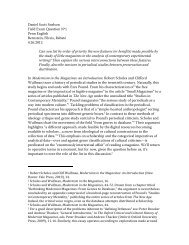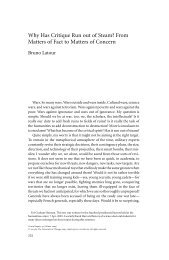The Exploit: A Theory of Networks - asounder
The Exploit: A Theory of Networks - asounder
The Exploit: A Theory of Networks - asounder
You also want an ePaper? Increase the reach of your titles
YUMPU automatically turns print PDFs into web optimized ePapers that Google loves.
Notes 175<br />
61. For a popular overview and discussion <strong>of</strong> computer viruses, see<br />
Stephen Levy, Artificial Life (New York: Vintage, 1992), 309.<br />
62. See Fred Cohen, “Computer Viruses: <strong>The</strong>ory and Experiments,”<br />
Computers and Security 6 (1987): 22– 35. Also see Cohen’s much - referenced<br />
study <strong>of</strong> computer viruses, A Short Course on Computer Viruses (Pittsburgh:<br />
ASP Press, 1990).<br />
63. <strong>The</strong> Web sites <strong>of</strong> antivirus s<strong>of</strong>tware makers such as Norton Utilities<br />
contain up - to - date statistics on currently operational computer viruses.<br />
64. On computer viruses as a - life, see Eugene Spafford, “Computer<br />
Viruses as Artificial Life,” in Artificial Life: An Overview, ed. Christopher<br />
Langton (Cambridge: MIT Press, 2000).<br />
65. <strong>The</strong>se and other SARS figures are contained in the Web sites for the<br />
WHO and the CDC. For a recent Rand report on emerging infectious diseases,<br />
see Jennifer Brower and Peter Chalk, <strong>The</strong> Global Threat <strong>of</strong> New and Reemerging<br />
Infectious Diseases (Santa Monica: Rand, 2003).<br />
66. See Eugene Thacker, “Biohorror/ Biotech,” Paradoxa 17 (2002); and<br />
“<strong>The</strong> Anxieties <strong>of</strong> Biopolitics,” Infopeace.org (Information, Technology, War,<br />
and Peace Project) (Winter 2001), http: // www.watsoninstitute.org.<br />
67. “It would be neither the fold nor the unfold...but something like<br />
the Superfold [Surpli], as borne out by the foldings proper to the chains <strong>of</strong> the<br />
genetic code, and the potential <strong>of</strong> silicon in third - generation machines....<br />
<strong>The</strong> forces within man enter into a relation with forces from the outside,<br />
those <strong>of</strong> silicon which supersedes carbon, or genetic components which supersede<br />
the organism, or agrammaticalities which supersede the signifier. In<br />
each case we must study the operations <strong>of</strong> the superfold, <strong>of</strong> which the ‘double<br />
helix’ is the best known example.” Deleuze, Foucault, 131– 32.<br />
68. Roland Barthes, <strong>The</strong> Pleasure <strong>of</strong> the Text (New York: Hill and Wang,<br />
1975), 40.<br />
69. Deleuze goes on to describe how Foucault’s work with power reached<br />
a certain wall, a limit concerning the silence on the part <strong>of</strong> those subjected<br />
by disciplinary systems such as prisons. This led Foucault to form the GIP<br />
(Prisoner’s Information Group), opening a new discourse between prisoners,<br />
activists, and intellectuals, which decisively informed his work in Discipline<br />
and Punish. But the same can be said <strong>of</strong> Deleuze, or anyone doing cultural,<br />
social, and political work; one identifies a certain limit point, beyond which<br />
something must change. That something could just as easily be concepts as it<br />
could be methodology. Or it could be the discarding <strong>of</strong> a previous set <strong>of</strong> practices<br />
altogether. Further, it could also be a lateral jump from one discipline to<br />
another, from a discipline based on theory to one based on practice. Whatever<br />
the case, the limit point Deleuze describes is implicit in theoretical work,<br />
and this is our responsibility here in addressing protocological control.<br />
70. Deleuze, “Intellectuals and Power,” 205– 6.<br />
71. Geert Lovink, Dark Fiber (Cambridge: MIT Press, 2002), 9.









